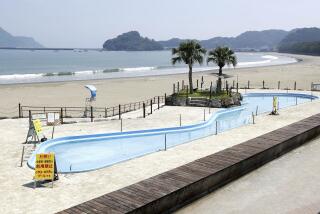Japan plagued by aftershocks -- 27 of them magnitude 6 or greater
- Share via
Japan continued to be rocked by aftershocks Saturday following Friday’s 8.9 magnitude earthquake.
The nation has experienced more than 154 aftershocks of magnitude 5 or greater since the earthquake, according to Paul Caruso, a geophysicist with the U.S. Geological Survey earthquake information center in Golden, Colo. Of the aftershocks, 27 have been magnitude 6 or greater, Caruso said.
Photos: Scenes from the earthquake
Caruso said it was difficult to determine how long the aftershocks will last.
“We don’t have a lot of experience with earthquakes this large,” he said. “We expect the aftershocks to continue and we don’t know when they might stop. Aftershocks can go on for months or years with big earthquakes. We’re still getting aftershocks from the Chile quake last year.”
Caruso said some researchers maintain that Chile has recently experienced aftershocks from a 9.5-magnitude earthquake back in 1960.
“The bigger the earthquake, the longer the aftershocks can last,” Caruso said. But, he said, aftershock activity had decreased Saturday morning.
“It’s calmed down quite a bit in the last hour,” Caruso said. “When I first got here they were going off right and left.”
Caruso said it would take an aftershock of at least a magnitude 7 to generate a tsunami. Although the National Oceanic and Atmospheric Administration has lifted the tsunami warning issued after Friday’s earthquake, Caruso cautioned that, “We may still have aftershocks that are that large.”
Gerard Fryer, a geophysicist at NOAA’s Pacific Tsunami Warning Center in Hawaii, said he was still on the lookout for tsunami activity near Japan.
“We have to remain vigilant,” Fryer said.
He said he was also anticipating the possibility of a second earthquake in the region, similar to the 8.6 magnitude quake in Sumatra in March 2004 following another massive quake the previous December.
“Great earthquakes seem to beget great earthquakes,” Fryer said.
He said residents should be prepared for another quake in the near future, and aid workers should come prepared for aftershocks and future quakes that could further destabilize damaged roads and buildings.
“The biggest hazard is the possibility of future aftershocks and buildings that are already damaged,” he said. “It might tip them over the edge. It’s a hazardous undertaking to go do rescue work.”
In the town of Minamisanriku, 9,500 people remained unaccounted for late Saturday, Japan’s Kyodo News Agency reported -- about half of the town. More than 3,000 people had been rescued, Japanese Prime Minister Naoto Kan told the news agency.
“We’d first like to focus on saving lives and secondly the comfort of the evacuees,” Kan said. “There will be many resources that will be needed for this evacuation process.”
To aid the search for those missing in the wake of the earthquake, Google launched an interactive database that allows users to search and submit information about the injured and missing.
Google first launched Person Finder after the Haiti earthquake and has since used it to aid in rescue efforts after the Christchurch, New Zealand, earthquake on Feb. 22.
As of Saturday, there were more than 65,400 records on Person Finder, available in Japanese and English.
Also:
Japan’s fears mount with nuclear plant blast
Google’s Person Finder for Japan quake
Photos: Japan’s quake and tsunami aftermath
Video:Dramatic images emerge from California coast
More to Read
Sign up for Essential California
The most important California stories and recommendations in your inbox every morning.
You may occasionally receive promotional content from the Los Angeles Times.











